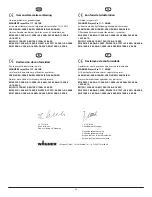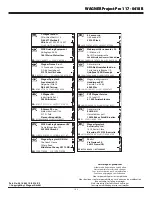
17
WAGNER Project Pro 117 - 0418B
Danger
Keep hands clear from fluid stream. Ground the gun
by holding it against the edge of a metal container
while flushing. Failure to do so may lead to a static
electric discharge which may cause a fire.
3. While pulling the trigger, switch the pump ON (l), and turn
the PRIME/SPRAY knob to Spray. Hold the trigger until all air,
water, or solvent is purged from the spray hose and material is
flowing freely.
Danger
If the PRIME/SPRAY knob is still on SPRAY, there will
be high pressure in the hose and spray gun until the
PRIME/SPRAY knob is turned to PRIME.
4. Release trigger. Turn the prime/spray knob to PRIME. Turn
the pump OFF (O). Trigger the gun into the waste container to
be sure that no pressure is left in the hose.
Figure 9 - Attaching the Spray Tip
Danger
POSSIBLE INJECTION HAZARD. Do not spray
without the tip guard in place. Never trigger the
gun unless the tip is in either the spray or the unclog
position. Always engage the gun trigger lock before
removing, replacing or cleaning tip.
1. Lock the spray gun off.
2. Thread the tip guard onto the gun.
i
When attaching the tip guard to the gun, align the tip
guard as shown in figure 9 (a), then tighten by hand (b).
Spraying
Figure 10 - Spraying Technique
A) The key to a good paint job is an even coating over the entire
surface. Keep your arm moving at a constant speed and keep
the spray gun at a constant distance from the surface. The
best spraying distance is 25 to 30 cm between the spray tip
and the surface.
B) Keep the spray gun at right angles to the surface. This means
moving your entire arm back and forth rather than just flexing
your wrist.
C) Keep the spray gun perpendicular to the surface, otherwise
one end of the pattern will be thicker than the other.
D) Trigger gun after starting the stroke. Release the trigger
before ending the stroke. The spray gun should be moving
when the trigger is pulled and released. Overlap each stroke
by about 30%. This will ensure an even coating.
i
When finished spraying, perform Pressure Relief
Procedure.
i
If you expect to be away from your spray project for
more than 1 hour, follow the Short Term Cleanup
procedure described in the Cleanup section of this
manual.
Figure 11 - Practice
1. Be sure that the paint hose is free of kinks and clear of objects
with sharp cutting edges.
2. Slide the PressureTrac™ to its to its lowest setting.
3. Turn the PRIME/SPRAY valve to SPRAY.
4. Slide the PressureTrac™ to its highest setting. The paint hose
should stiffen as material begins to flow through it.
5. Unlock the spray gun.
6. Trigger the spray gun to bleed air out of the hose.
7. When material reaches the spray tip, spray a test area to check
the spray pattern.
8. Use the lowest pressure setting necessary to get a good spray
pattern (A). If the pressure is set too high, the spray pattern
will be too light. If the pressure is set too low, tailing will
appear or the paint will spatter out in blobs rather than in a
fine spray (B).
Figure 12 - Unclogging the Spray Tip
i
If the spray pattern becomes distorted or stops
completely while the gun is triggered, follow these
steps.
Danger
Do not attempt to unclog or clean the tip with your
finger. High pressure fluid can cause injection injury.
1. Release the trigger and lock the gun off. Rotate the reversible
tip arrow 180º so that the point of the arrow is toward the rear
of the gun (see figure 12).
i
Under pressure, the spray tip may be very difficult to
turn. Turn the PRIME/SPRAY knob to PRIME and
trigger the gun. This will relieve pressure and the tip
will turn more easily.
2. Turn the PRIME/SPRAY knob to SPRAY.
3. Unlock the gun and squeeze the trigger, pointing the gun at
a scrap piece of wood or cardboard. This allows pressure in
the spray hose to blow out the obstruction. When the nozzle
is clean, material will come out in a straight, high pressure
stream.
4. Release the trigger and lock the gun off. Reverse the tip so
the arrow points forward again. Unlock the gun and resume
spraying.





































